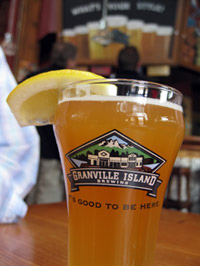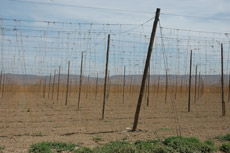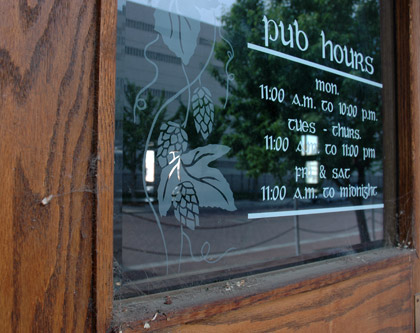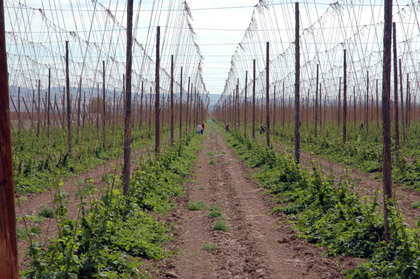Seattle deserves to be in any discussion about the nation’s best beer drinking cities, but we’re not going there again.
Our recent brief stay in the region wasn’t about beer — in stark contrast, for instance, to 1995 when we visited dozens of places while working on the “The Beer Lovers Guide,” sometimes feeling frantic but also finding time to relax at gems like Latona Pub and The Blue Moon — but it’s ingrained in the culture so we accidentally bumped into a little along the way.
A few observations:
– The changes at Pike Brewing since the 2006 Craft Brewers Conference was in town are simply stunning. Founders Charles and Rose Ann Finkel bought the pub and brewery back shortly after the conference ended and — let’s be perfectly honest — rather quickly erased eight years (that’s how long it was out of their hands) of neglect.
When we visited in 1997, a year after the pub opened (the brewery started in 1989), Charles had set aside one room as the beginning of a museum. When I returned in 2006 I was sadly surprised to learn it was one of the first things to go after the brewery/pub changed hands.
The concept is back with a vengeance. Breweriana is everywhere, from signs to tap pulls and trays to photos — all presented thoughtfully. It made me think of the Bavarian Brewery Museum in Kulmbach because of its educational nature. Still great eye candy, but one wall explains how beer is made, another traces its history, there’s a case that will be Washington-centric, a wall devoted to Prohibition, a case paying tribute to Micheal Jackson . . .
All exciting enough to make up for the disappointment at the American Hop Museum.
I’m not sure how many in the very large lunch crowd cared about this, but figure there was some beer education by osmosis going on.
The food is more than a cut above, although Rose Ann said that they urged food reviewers not to hurry in until recently. Many of the ingredients are sourced locally, so the pizza was not available because the cheesemaker who provides mozzarella was dealing with sick cows.
Did the beer taste better because of the setting, and because (full disclosure) we were chatting over lunch with with Charles and Rose Ann (more about the breweriana and beer history than beer itself)? Perhaps it was the context, but it seemed improved. Head brewer Drew Cluley is now using organic pale malt from Gambrinus as the base for all the beers. As well as being organic and produced regionally it adds a rich character I associate with English malts.
Monk’s Uncle, brewed in the manner of a Belgian tripel, was one of the few bottled beers we bought later at Bottleworks. Bright aromatics (fruity, pears and peaches, spicy), nice hop flavors and bitterness, properly dry and digestible. Doesn’t seem to be getting much love at the beer rating sites, but it suits my palate and has a nice country earthiness.
– The neon at the Fabulous Buckaroo Tavern is still fabulous.
– Bottleworks makes the drinking local plan a little painful. It’s hard not to reach for bottles of Lost Abbey, Jolly Pumpkin, but hardest of all was passing on the bottle of Sierra Nevada’s Southern Hemisphere Harvest Ale.
– In “The Great Wines of America” author Paul Lukacs picks mostly wines with a 10-year track record. Not sure that’s necessary with beer or bars/taverns, but there is something to be said of longevity. I hate it when we recommend a place and somebody reports it has gone downhill.
So it’s nice to visit a place like Fred’s Rivertown Alehouse in Snohomish (it’s not that far from Seattle) and find the beer (both range and quality) outstanding and the food excellent. We were short time as we headed north from Seattle and had to pick between doing by Diamond Knot in Mukilteo and Fred’s. We would have liked to have seen DK founders Brian Sollenberger and Bob Maphet, but figured they’d be at their day jobs.
So we went to Fred’s and drank Diamond Knot IPA (and a few other beers).
Good compromise.
 Hey, nobody asked us if we wanted lemon.
Hey, nobody asked us if we wanted lemon. Let’s start with good news from Yakima. Here’s one of several new hopyards we saw Sunday and Monday. You can see why farmers point out it takes more than a year to make a hop field productive. Hops are well up the strings in nearby fields.
Let’s start with good news from Yakima. Here’s one of several new hopyards we saw Sunday and Monday. You can see why farmers point out it takes more than a year to make a hop field productive. Hops are well up the strings in nearby fields.
